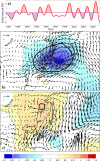Association of Kawasaki disease with tropospheric wind patterns
- PMID: 22355668
- PMCID: PMC3240972
- DOI: 10.1038/srep00152
Association of Kawasaki disease with tropospheric wind patterns
Abstract
The causal agent of Kawasaki disease (KD) remains unknown after more than 40 years of intensive research. The number of cases continues to rise in many parts of the world and KD is the most common cause of acquired heart disease in childhood in developed countries. Analyses of the three major KD epidemics in Japan, major non-epidemic interannual fluctuations of KD cases in Japan and San Diego, and the seasonal variation of KD in Japan, Hawaii, and San Diego, reveals a consistent pattern wherein KD cases are often linked to large-scale wind currents originating in central Asia and traversing the north Pacific. Results suggest that the environmental trigger for KD could be wind-borne. Efforts to isolate the causative agent of KD should focus on the microbiology of aerosols.
Figures





References
-
- Kawasaki T., Kosaki F., Okawa S., Shigematsu I. & Yanagawa H. A New Infantile Acute Febrile Mucocutaneous Lymph Node Syndrome (MLNS) Prevailing in Japan.Pediatrics 54, 271–276 (1974). - PubMed
-
- Taubert K. A., Rowley A. H. & Shulman S. T. Nationwide survey of Kawasaki disease and acute rheumatic fever. The Journal of pediatrics 119, 279–282 (1991). - PubMed
-
- Burns J. C. & Glodé M. P. Kawasaki syndrome. The Lancet 364, 533–544 (2004). - PubMed
-
- Suzuki A., Kamiya T., Kuwahara N., Ono Y., Kohata T., Takahashi O., Kimura K. & Takamiya M. Coronary arterial lesions of Kawasaki disease: Cardiac catheterization findings of 1100 cases. Pediatric Cardiology 7, 3–9 (1986). - PubMed
-
- Kato H., Sugimura T., Akagi T., Sato N., Hashino K., Maeno Y., Kazue T., Eto G. & Yamakawa R. Long-term Consequences of Kawasaki Disease: A 10- to 21-Year Follow-up Study of 594 Patients. Circulation 94, 1379–1385 (1996). - PubMed
Publication types
MeSH terms
Grants and funding
LinkOut - more resources
Full Text Sources
Medical

